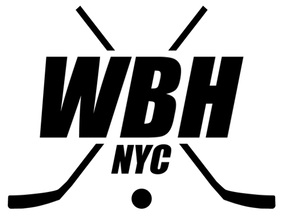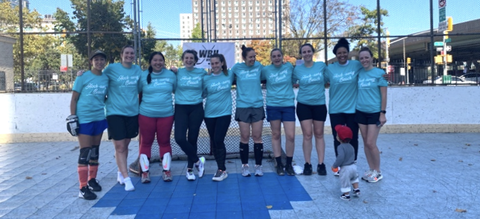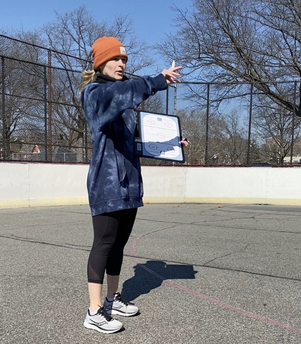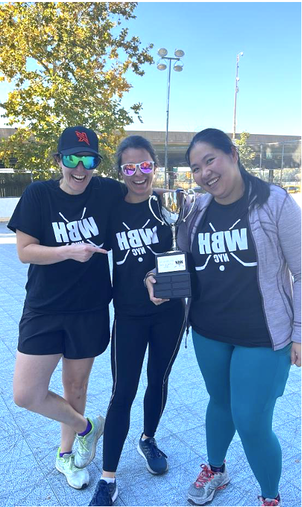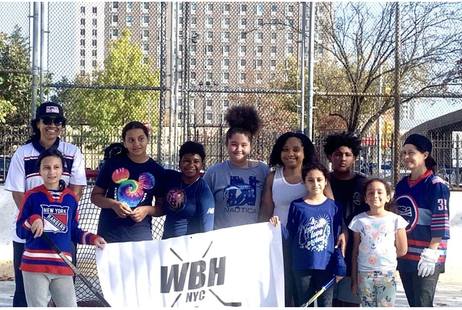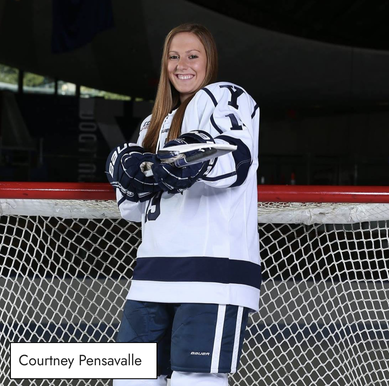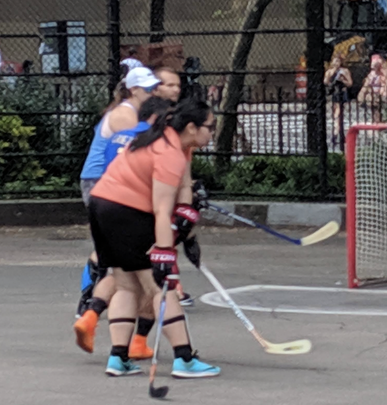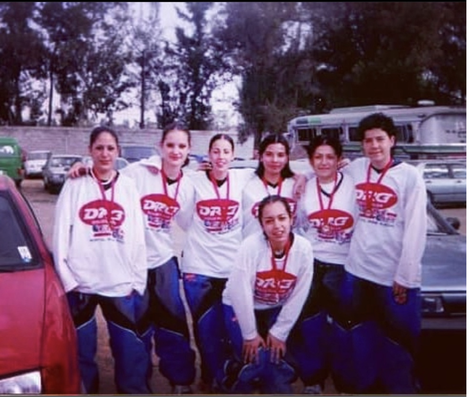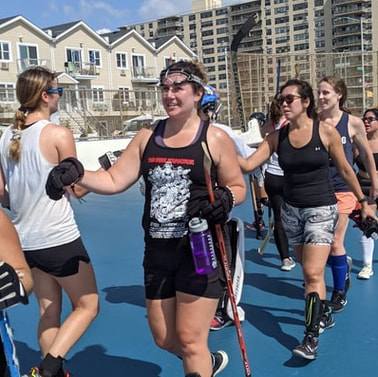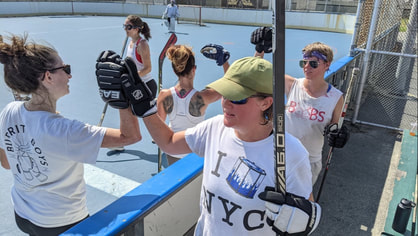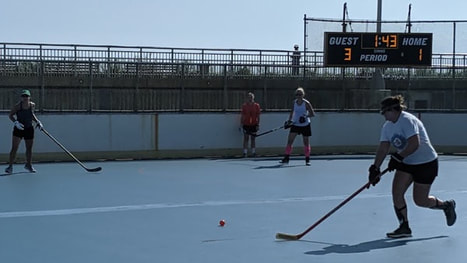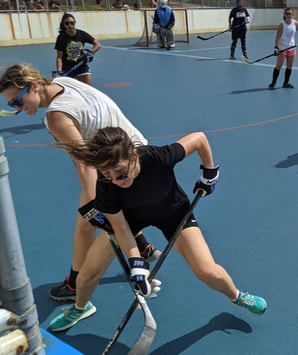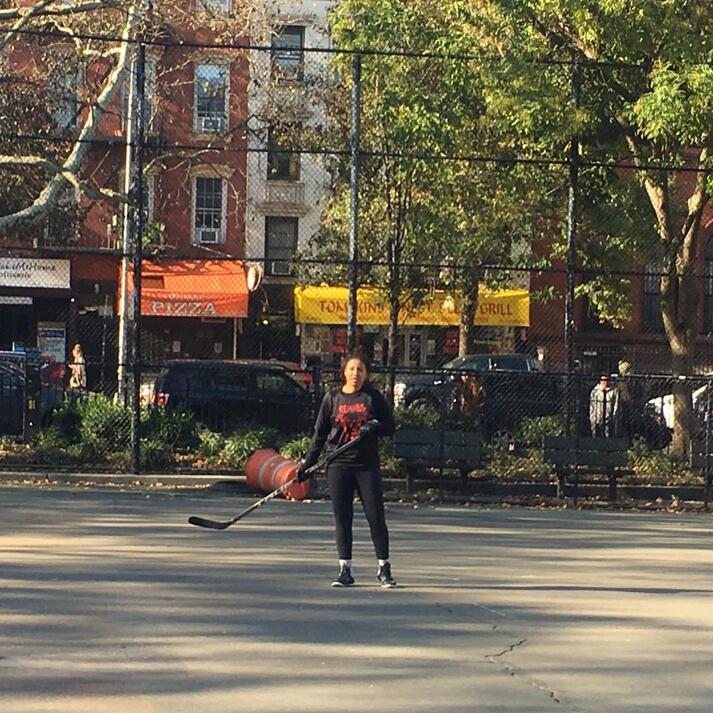|
Ellie Milewski “Hockey is For Everyone.” Hockey is for everyone. The hope for this pursuit is that it permeates every level of the sport. It’s a slogan, a movement, a mission. It’s a promise. It’s something to constantly strive for. But there lies an undeniable necessity for another word as well, that is just as vital to this mission: if hockey is to truly be for everyone, it must be by everyone. This recognition of community and strong belief in what people can achieve together is a core value of Marcella Coulson, Founder & President of Women’s Ball Hockey NYC. Though her leadership is a backbone of the WBHNYC organization, Coulson never ceases to point the spotlight outward, reminding each member of the community that the programming and access WBHNYC is able to provide is made possible by them. “They are the ones making things happen. When every person sees the impact and difference they can make, that everyone is making, they're even more inspired to step up. We all are. ” ~ Coulson grew up over 400 miles north of the Big Apple in Burlington, Ontario, just outside of Toronto. Her love of ball hockey was born on the pavement of her parents driveway where she would shoot around with her neighbors. In 2016, she moved to New York City, bringing her passion for inclusive leadership and equity in sport with her. She also brought her pure love of hockey. And what did she find? Immense possibility to grow the women’s game. The NYC ball hockey community was alive and within it was a diverse community of intelligent, supportive, and resourceful women who were passionate about the game. How many more women were there in this concrete jungle who’d simply never been given the chance to play or who didn’t know that there was a space for them in the game of hockey? “I believe people can do anything if they have equitable access to the resources and support needed to succeed. Providing that access in hockey and breaking down barriers to participation is a big part of what we are trying to do,” Coulson shares. “I believe that in order to harness the full potential sports have to bring people together, we need to put in the work to ensure they are an inclusive space where everyone feels not only included and respected, but empowered to make things happen. Sometimes it’s not about waiting for the ball to come to you, but pushing forward and going after the ball and taking the shot. [We] need to ensure everyone has an equitable opportunity to do this – that’s the issue. It’s not like everyone has a fair shot to do this. Not yet. We need to keep listening and working towards making space for All women in the sport.” Luckily, rather than being a “wait-around-until-it-feels-possible” type of woman, Coulson had a “we-are-going-to-make-this-possible” mindset. The group of women she’d met in New York City shared that same hunger. In 2018, the non-profit organization, Women’s Ball Hockey NYC, was born. It was created for women who’d grown up playing the sport just as much as it was created for women who’d never considered the possibility. It was created for girls who’d dreamed of hockey but never been given the opportunity, and for girls who’d never heard hockey could be played in sneakers. It was created with the unifying mission statement: “To strengthen the NYC ball hockey community by specifically empowering female players of all ages through opportunities that foster inclusiveness, allyship, and respect.” WBHNYC was able to be formed for this community because it was founded by a group of women who saw an opportunity to expand the game of hockey. Let’s jump forward half a decade and take a look. WBHNYC has now held four Hock-away Women’s Ball Hockey tournaments for women in the NYC community and beyond. The organization hosts skill clinics and scrimmages run and organized by female leaders and volunteers. In the summer of 2022, WBHNYC organized the first ever women’s ball hockey league in the history of New York City. The inaugural season consisted of 3-teams, captained by Lauren Jones, Ryann Geldner/Charlotte McAuley, and Courtney Pensavalle. While The Liberty Cup was lifted for the first time by The Black Widows, it was truly lifted by an entire community who came together to make the league possible. November 2022 brought another huge moment for the organization when WBHNYC kicked off its youth programming with an all-girls “Learn to Play Street Hockey” clinic. The clinic was led by certified coach, decorated player, and women’s ball hockey leader, Cherie Stewart. This implementation of youth programming continued in the new year as WBHNYC teamed up with John H. Finley School and USA Ball Hockey to provide its first youth series. The coaches in the series were WBHNYC volunteers and allies who dedicated their time to bring hockey to a group of kids, many of whom had never held a stick before. Ryann Geldner – teacher, coach, and valued member of the WBHNYC community – spearheaded this youth series, as her most recent endeavor as an unwavering advocate for youth hockey in New York City. It is incredible to see how far Women’s Ball Hockey NYC has come, especially knowing that this is still only the tip of the iceberg.
But the true impact of WBHNYC and the growth of this community cannot be seen in event titles or lists. It’s something that is felt. It’s felt when at the end of their first youth clinic a group of girls and boys alike gather in a circle, put their hands together and scream out “Hockey for fun!” It’s felt when on a sunny day, as league members gather together on the rink for a skills clinic and scrimmage, a woman comes up and introduces herself, asking who we are and what we do because she says it just looks like we are having so much fun. It’s felt when a new player gets their first goal. “During our National Girls and Women in Sports Day scrimmage a newer player scored her first goal. She immediately exclaimed, ‘that’s my first goal!’ and I watched her entire team gather round her with huge smiles and high fives,” shares Lauren Jones, Co-founder and treasurer of WBHNYC. “And what’s amazing about our community isn’t the fact that we celebrate our own goals, it’s that we celebrate the goals of our teammates.” It’s felt through the joy. It’s felt through the adversity. “As a founding board member of WBHNYC, I have always recognized our work as empowering. Never have I appreciated it more than this past year, when I was diagnosed with a rare disorder that has compromised my mobile skills and changed my whole way of life,” say Mia Juhng. “This shift has not altered my way of thinking, however: strength, both physical and mental, can come from feeling capable. Women lifting each other up is a very powerful means of cultivating resilience, something I lean into very heavily in tandem with my love of hockey.” The impact of this community is felt. It’s often said that you have to “see it to believe it.” But when you feel it? Well, that takes on an entirely new power. “The community is truly wonderful and welcoming and allows New Yorkers to connect with other individuals who they may normally never meet,” shares WBHNYC member Kelly Groglio (KG). “I think what is great about hockey for women is that it encourages us to confidently take up space, be aggressive, and assertive; which isn't something women are historically taught or empowered to do. Combine this with a positive and supportive community of other women and you will make meaningful connections and have a lot of fun.” Long Island local, coach, and player, Meghan Lavery, shared a similar opinion. “Playing in NYC with your whole hockey crew has been amazing,” she said. “Every time I see you guys it always makes me feel like the women's ball hockey community is growing and it’s exciting to finally see it happen locally. I hope to be a part of bringing Long Island and NYC hockey women together one day.” Lavery expressed this after driving over an hour bright and early on a Saturday morning to help coach children at a youth clinic. “I hope that all the kids but especially the girls stick with hockey,” she added. “And I hope that seeing women teaching the clinic resonates with them. I think that seeing a woman in that role gives the girls a little extra boost of confidence to keep at it. Its special to be a part of an organization/community who are giving girls the tools they need to play this amazing game.” WBHNYC member and coach Annie Artz chimed in after also spending her Saturday morning in the school gym. “What I love about coaching young kids is pretty simple: it’s seeing what a great time they are having while playing hockey. It’s such a fun way to give back to a sport and community that’s given me so much.” Hockey is for everyone. Hockey is by everyone. As we look back on these five years of Women’s Ball Hockey NYC, and perhaps more importantly, as we look forward, it is impossible not to take a moment to celebrate who the WBHNYC community is by. Because in this organization’s story there is not one sole author. There is a constant flood of creators and each new page brings another person who makes this possible. Women’s Ball Hockey NYC is by the women who cram into the subway with all their gear to make a scrimmage. It’s by the leaders who work to get permits for the rinks. It’s by the bagel shop who donated food so that the kids trying the sport for the first time had breakfast. It’s by the coaches who risked a parking ticket to make it on time to lead a clinic. It’s by the security guard who opened the doors to the school. It’s by the male allies who act as referees, goalies, and volunteers. It’s by the caregiver who stumbled in after working a night shift and told us he came right to the gym rather than going to bed because of how much his child wanted to play hockey. It’s by the women who take a portion of their paycheck to give to growing the game of women’s hockey. It’s by the teammate who cheers when you get a goal. It’s by the teammate who cheers when you don’t. Women’s Ball Hockey NYC is by the people who show up for each other, for the game of hockey, and for women’s empowerment. “I love playing sports because they remind me how much more I have to give,” says Coulson. “Even when I think I have nothing left, I somehow find a little more. I think this is especially true of team sports, where I feel almost limitless in my capacity to give more for my teammates — I always work hardest when I’m not just playing for myself but for others. It’s not about you, it's about what the team can do. Sports has taught me a lot about humility and community, which has kept me playing. Hockey without community is just a game — its the moments we share that make the sport so memorable.” WBHNYC is by everyone in this incredible community. That’s what makes its mission possible.
0 Comments
 Every hockey player has a unique story of how they found the sport, or how the sport found them. “I grew up in Maine with two older brothers,” Meg Fortier shares. “Like most little sisters, the most important thing in the world to me was trying to keep up with them. When they played ice hockey, I quickly followed suit. Most backyard scrimmages, I was stuck playing goalie so they could play 1v1, yet I still loved every second.” Courtney Pensavalle had a similar experience, growing up playing ice hockey with boys in Massachusetts. All the way across the country, Cherie Stewart got her start in roller hockey at the age of twelve, in Lake Forest, California. Cherie Stewart. Courtney Pensavalle. Meg Fortier. Though they found hockey in different places and for different reasons, their stories intersected years later on the streets (and courts) of New York City. With the nickname “concrete jungle,” it is no wonder that ball hockey is both an accessible and growing sport in New York City. It is the reason that these three women first found themselves part of the same hockey community. A community that – while stemming from New York City – reaches far beyond. “Playing hockey in NYC has shaped me in many ways,” Cherie shares. “I learned how to play ball hockey here and it’s given me opportunities to play internationally (Switzerland, Czech Republic, Bermuda, Slovakia, and Canada) and for that I am grateful. Over the years, I’ve met some amazing people across the country through this sport and it’s expanded my hockey network more than I could have imagined. I’ve had the privilege to coach Team New York U16 girls team and introduced this sport to others as well which means a lot to me too. Overall, I fully embraced this sport and gave everything to it – it’s been quite a journey of wins, losses, and life lessons. “While NYC hockey leagues can pose some challenges, if the compete-level or league culture isn’t aligned, if you find the right fit, then you’re golden,” Cherie continues. “The NYC hockey grind lifestyle might not work for everyone but if you can make it here…you can make it anywhere!"  “I likely wouldn't be playing ball hockey at all had I not moved to NYC!” Meg weighs in. “I was playing in a men's ice league at Lasker in 2019 when I met Becca Cohen who introduced me to the women's Thursday Night Skate. As our winter skate was winding down everyone recommended I join BTSH (Black Top Street Hockey) and here I am many years later. I had no idea how impactful ball hockey would be to my life, but the community has been so welcoming and so many of the individuals involved have become life-long friends; it's great to be a part of ball hockey in NYC and it's something I'll surely miss as I get ready to move.” But before making the move from NYC to Colorado, Meg had one more stop to make: Quebec, Canada. On June 17-25, Cherie (#13), Courtney (#19), and Meg (#12) represented the United States of America as members of the US Women’s National Team. These elite female athletes who first played together in New York City, earned the chance to compete together on a world stage. Before leaving for Quebec, they shared their thoughts on what the moment meant to them: “Having grown up playing ice hockey with boys my whole life, I dreamt of playing on a team with all women and representing my country,” Courtney said. “I am so honored and excited to wear the USA jersey and to compete alongside elite female ball hockey players around the world.” 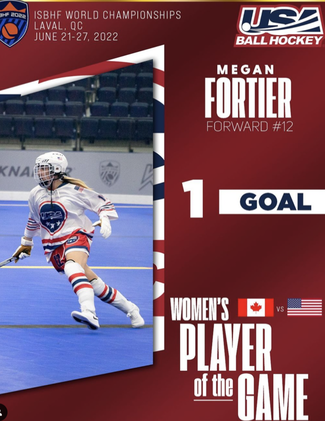 “It is such an honor to play for Team USA,” said Cherie. “Playing with and against some of the best players in the world and performing on the biggest stage. The feeling when you step onto the rink with the USA jersey on with your teammates, hearing the anthems, the lights, the cheers (and jeers!) – there’s nothing like it and I love it. Every opportunity to play for this team is a privilege and I want to play my best and hopefully make my family and country proud.” The importance of family and community was something Meg highlighted as well. “While my brothers have certainly been role models, my dad, a former collegiate hockey player, has really been my mentor, and at times my coach in the sport,” Meg shared. “He and my mom have traveled countless miles over the years to watch and support my journey. This week is no different as they make the trek up to Canada.” As payoff for making the trek, Meg’s parents got to see her recognized as the Women’s Player of the Game after scoring team USA’s only goal during their first game against Canada. Cherie, Courtney, and Meg all competed hard in the following days, acting as key pieces in team USA’s victories against Slovakia, Great Britian, Lebanon, and the Czech Republic. Though they lost to Slovakia in the playoffs, coming in 4th overall, the competition was a testament not only to these three women’s skill and compete level, but to their leadership in the sport, and to their importance to the ball hockey community in New York City and beyond. As Meg gets ready to move and bring her hockey expertise to a new place, she will forever remain an important member of the NYC ball hockey community. Cherie continues to be a force both as a coach and player in New York City and beyond. And Courtney is getting ready to captain a team in the first ever Women’s Ball hockey League in New York City. “Competing at the National Ball Hockey World Championships was a special experience,” Courtney shares. “It was a honor to represent my country and to play at the highest level among my female peers. Furthermore, I appreciated the opportunity to meet players from all over the world and to connect through our shared passion for ball hockey.” For these women, all the world truly is a rink: the possibilities are endless. By, Ellie Milewski
By, Susie Lai To fit in. That’s the only reason why 14-year-old me began watching hockey. Everyone in my classes were talking incessantly about the Tampa Bay Lightning making it to the Stanley Cup Finals for the first time in franchise history. I remember sleepovers at my friend’s house where there were Lightning magnets with schedules all over the fridge door. My family was one of the few Chinese families in my small town just north of Tampa, Florida, and the sport of hockey was something foreign to us, much like most of American culture. I knew soccer because my dad loved it, and I had periodically watched it with him growing up. But hockey? We had never even heard of it! However, while the concept of a sport on ice was pretty foreign to a place like Florida, the Lightning had somehow captured everyone’s attention. So, to fit in with my classmates – none of whom looked like me – I started watching a sport where none of the players looked like me. But that’s not unusual. Despite the fact that AAPI (Asian Americans and Pacific Islanders) is one of the faster growing racial groups in the US, now at 35.5% as per the 2020 Census, there is still a severe lack of AAPI players in all major sports across the US, and hockey is no exception. When I started watching hockey the year Tampa Bay won it all, the list of AAPI players active within the NHL was so small you could count them on just one hand, with Paul Kariya (bet you didn’t know that!) being the most prolific of them all. But I didn’t know that back then. I just knew that hockey seemed like a fun sport, and it gave me something in common with everyone else. So I started watching. I moved to upstate New York to go to Cornell for college. If there’s any sport that Cornell was good at (Ivy Leagues are usually atrocious at sports), it was hockey. I joined the pep band, so every Friday and Saturday night, I’d be right there cheering on our hockey team. I loved being a hockey fan at Cornell, and found a diverse community in the “Lynah Faithful,” the fans who spent weekend after weekend at Lynah Rink cheering on our men and women’s hockey teams. I loved that community and I started learning how to play, joining every intramural ball hockey league I could. I didn’t know what I was doing, yet relished every minute of it. (Shout out to my team “Rainbow Sunshine Lollipop Fairies.” We were the champions of the womens intramural ball hockey league 3 years running from my sophomore to senior year!) When I moved to NYC right after grad school, I knew that the hockey community was one that I wanted to find. Joining a co-ed ball hockey league was one of the best decisions I’ve ever made. The team I joined was, at the time, made up of almost 40% AAPIs, which was rare! And while there still are not that many of us around the league, I’ve started seeing more and more AAPI players over the years. When I found this women’s hockey community, started by some of the AAPI women that I knew and admired, with its inaugural Hockaway Beach tournament, I jumped in head first. There was something about the energy of women’s hockey that felt different than playing in the co-ed league. Don’t get me wrong, I love playing co-ed ball hockey, but playing with women who actively included each other, helped teach each other, passed to each other, cheered each other on, and consoled each other when mistakes were made was so incredibly refreshing. This was a community filled with some of the most uplifting and inspiring women I’d ever met, all of whom had their own stories to tell. I’ve never really shared my own experiences of being AAPI – I grew up immersed in two different cultures, and the reconciliation of that can be exhausting. However, because of the pandemic these past two years and the resulting uptick in violence against the AAPI community, I found myself seeking out the AAPI community within my own communities, in order to share stories and support each other. There was story after story in the news, but also story after story that didn’t make the news. Within the women in our hockey world, I was able to find understanding and, well, “community,” for lack of a better term. These women affirm, support, and validate my feelings.
There’s an unspoken joke that AAPIs tend to find each other, and in this community, I think we certainly did. I got to know quite a few of the AAPI women within ball hockey, and we all shared common experiences with each other in a way that felt cathartic. We sought each other out on the courts and it made the world feel a little bit friendlier. There’s something really wonderful about belonging to a community, and there’s something about hockey that really embodies the phrase “hockey is for everyone”. I love the ball hockey community here in NYC, but really, it’s the women within it that have made playing hockey here one of the most joyful and fulfilling things in my life. I started watching hockey as a kid wanting to fit in in an unfamiliar environment, and I’m so happy where it has led me today: feeling like I’m in a community where I truly belong. In the spirit of celebrating AAPI Heritage Month, I want to end with this joy: the town where I grew up in Florida has new ice rinks and new youth hockey programs. The next generation of AAPI kids (both boys and girls) now have the opportunity to learn how to play. I didn’t have that chance as a kid, and it warms my heart to know that my cousin’s kids who still live in Tampa now have that chance. The game is growing, and maybe one day soon it will be normal rather than noteworthy to see and root for AAPI players on our favorite teams and in our local hockey communities. Now wouldn’t that be something? “Women’s hockey.” Those are the two words Yuvia typed into Google when she decided it was time to try again. Not just “hockey,” but “women’s hockey.” In Mexico, a country where soccer and baseball rule sports, playing hockey is not an easy path for anyone, let alone a young girl. There seems to be a misconception that hockey is dangerous and therefore can’t be for a woman. Growing up in Guadalajara, this challenge was what first drew Yuvia to the sport at age twelve: she wanted to prove that it didn’t have to be just for boys. In fact, it wasn’t. While playing in co-ed leagues, Yuvia and her female teammates endured comments about how they—for the sole reason of being women—were unfit to play the sport. Though she still enjoyed playing co-ed, Yuvia fantasized about what it would be like to play in an all-female league. This yearning was partially a product of the obstacles she faced as a female player. But it also stemmed from a core human desire: the desire for belonging. “Being with other people like you, more women…” Yuvia says. “It’s not because you want to show off in the case that you’re better than other girls or women, it’s because you belong.” Unfortunately, the only time an all-female league was established during her youth was when the state fashioned a women’s field hockey team. Players were assembled and provided with space, time, and equipment. While the female camaraderie was what Yuvia desired, the different type of hockey was not. The short, curved stick felt unfamiliar in Yuvia’s hand. Rather than being for the athletes, it seemed that the athletes themselves were being used so the state could fill a female quota. But Yuvia did not see her femaleness as a token, and though she desired the special quality of being on a women’s team, she was unwilling to compromise her passion. So Yuvia focused on opportunity rather than obstacle. Whether it was a lack of female teammates, the sparse and expensive equipment, or the crack of dawn ice times that called for 30-minute walks laden with gear, she showed up with gratitude. “We didn’t care,” Yuvia recalls. “We were like, this is what we have, and we’re going to do it.” Above all else, Yuvia never stopped dreaming of progress and representation in the sport she loved. Together, she and her friends would wonder, “What if there’s a world or there’s a city where you can, you know, have women’s leagues…?” In her early 20s, that dream seemed on the cusp of reality. Yuvia was invited to be a member of the first women’s national roller hockey team in Mexico. At that time, she was also playing basketball, and had been for years. In fact, many of her friends and family assumed basketball was her chief passion, and Yuvia felt they didn’t understand just how personal hockey was for her: it held her heart. As a result, she decided that her next basketball tournament would be her last. It was. But sadly, it was more than basketball that ended. During the tournament, Yuvia’s knee was seriously injured. Her athletic career came to a halt just as women’s hockey was emerging in Mexico, and after a long recovery, Yuvia decided it was too risky to start again. Fast forward 15 years: “Women’s hockey.” Those are the two words Yuvia typed into Google when she decided it was time to try again. She’d been living in New York for about six years when the global pandemic struck. Difficult times have an uncanny way of uncovering silver linings and unlocking resilience. Yuvia found herself working out more from home and feeling stronger each day. “Suddenly, I was like… what if I tried again?” So Yuvia sought out the community she’d always dreamt of. The first thing to pop-up on her internet search bar was Women’s Ball Hockey NYC. Before she knew it, Yuvia was back on the rink as a part of the first all-female ball hockey league in New York City. “It’s super fun for me,” Yuvia shares. “… and also kind of all I wanted, so you know, I’m trying to enjoy that feeling and see what it feels like, because it’s something that I always dreamed when I was with my friends. We were talking like ‘yeah, imagine if we could go do this and that.’ And now it’s happening. It’s already done. So I want to be a part of that.” But playing with all women has not satiated her passion for growing the game, or satisfied the need she still sees for women’s hockey. “There’s more support, there are more women trying and playing and pursuing this game but still here, what I’ve noticed, is that there’s not enough,” she says. New York City has an abundance of space, tools, and possibility. Yuvia believes in exposing more women to hockey, and she endorses the classic phrase, “if you can see it, you can be it.” “If you see somebody doing it, someone like you—another girl, another woman—you can totally, totally feel and know that youcan do it.” Although Yuvia is now recovering from another knee injury, her optimism and excitement are palpable and inspiring. Hockey is not just a hobby, but an intrinsic part of her nature. Everything from skating to the blade of the stick mesmerizes her. She could think about hockey all day, and over the course of these many years, she has never stopped doing just that. Now back, Yuvia is motivated to help grow the types of women’s leagues that the little girl in Guadalajara, Mexico, could only dream about. By, Ellie Milewski
By, Tracy Miller What does it mean to play women’s hockey? If you ask one of the women in our community who grew up playing on boys’ teams because there was no girls’ team to join, or who excelled on women’s teams in college and beyond, I’m sure you might get a different answer than if you ask me—someone who first picked up a stick at age 32 to join a coed rec league. My experience on coed teams has been overwhelmingly positive. I was lucky to walk into an environment where male and female teammates alike supported me as I learned the game. Having that support from most people made it easier to brush off the times when I felt intimidated or superfluous around any others (mostly men, because coed hockey leagues are still mostly men) who were sometimes impatient with me because they were faster or more skilled or had been playing for much longer. But even despite that mostly positive experience, when I first had the opportunity to play in an all-women’s scrimmage, my immediate thought was, yes! Sign me up! Why is that, exactly? What, if anything, makes the women’s game different and exciting? If you had asked me before writing this article, I probably would have said “there’s just a different energy”--and vague though that may be, I think that many women would agree with me. Here’s my attempt at getting a little more specific about what makes our women’s hockey community special. 1. Women Want To Win As A Team Never once have I played on a women’s team where the same person was expected to dominate every play, or where the bench instructions were “just pass to this one person so she can score.” Maybe this vibe is more specific to the recreational level, but I’ve noticed it and I’m here for it. When I play well, I’m not the only one who sees it—unfailingly, someone will give me a compliment. Even if someone is struggling, the team’s reaction is more likely to be “is she OK?” or “let’s work with her on this skill” than “get her off the court.” The sense of teamwork and collective accomplishment on these teams is second to none, even if we’ve only been playing as a team for a few hours. 2. Women Pass To Me “But Tracy,” I can hear you saying, “maybe if you were BETTER AT HOCKEY, people would pass to you all the time, regardless of your or their gender.” That’s exactly my point. Women are more likely to pass to me when it’s the right move to make, rather than searching frantically for a better (or just a male) player to pass to instead. The bar to prove myself during a women’s game is being open. If I’m in the right spot, I’m probably getting the ball. I know that this is not just my experience, because the joy of getting the ball more often is commented upon at most of the women’s games I’ve been part of. It is nice to receive a pass and feel like you’re there for a reason and not just there to fill some sort of boob quota. 3. Women Apologize (Or Not) This can be refreshing, to have teammates that own their mistakes and care about each other’s feelings. But sorry is not always a good thing. On the ice, as in life, women are more likely to say “sorry!” even when it’s only questionably their fault or no one’s fault at all—I too am guilty of this (and of saying “oopsie,” because I’m from the Midwest). Women’s hockey is a great place to unlearn all of that. If you hurt someone or lose your temper, an apology is lovely. But I don’t want my teammate to say sorry when she overshoots a pass or misses a shot. Don’t even say sorry if you step on my foot or check me into the boards or get a little chippy during scrimmage. Aggression is not to be apologized for. If this is your inclination, try replacing “sorry” with “sh@!” or “fc$k.” The general meaning is the same and it sounds better. 4. Women Welcome Beginners After a few seasons of ball hockey, my female teammate and I wanted more, so we bought a bunch of used ice hockey equipment and signed up for the lowest women’s division at Lasker. And we suuuuucked. Oh how we sucked. We couldn’t skate backwards. We couldn’t stop. We couldn’t shoot with power on our shaky footing. Yet, the response to our sucking from our more hockey-experienced teammates was, genuinely: “That’s awesome you decided to try this. It’s so cool you’re here.” And so, instead of feeling guilty or embarrassed that we’d overstepped our abilities and were thereby ruining the season for everyone, we had fun and even improved a bit. That level of acceptance and welcome wasn’t something I’d found elsewhere. Women are so great at this, at making other women feel like they belong on the ice. And I think that may be my favorite thing about women’s hockey. We all want to see more people like us playing this sport. We value inclusiveness as well as competition. We love taking the time to teach people the fundamentals, and then celebrating their progress. If only that energy permeated every part of life. As for me, I’ll surely keep playing in coed leagues--but I embrace being a part of the Women’s Ball Hockey NYC community for whenever I need a dose of that unmatched different energy. By, Ellie Milewski For as long as I can remember, I’ve lived alongside hockey. My parents are die hard New York Rangers fans and it didn’t take long for my older brother, Jack, to follow suit. A home movie of him (age 4) chasing me (age 1) around and knocking me over with a miniature hockey stick was early proof of that. Rather than calling a tripping penalty, my parents took a video. Now don’t get me wrong, I always enjoyed hockey. Whenever we went to NHL games, I had a blast. We held shoot outs in our cul-de-sac and it was always fun to don a jersey and hunker down with my family to watch games in our basement. But I was clearly the least gung-ho of my family. When my parents talk about watching the Rangers’ 1994 cup run together as newlyweds, a nostalgic mist falls over their eyes. My brother became a hockey play-by-play announcer for a minor league team. But me? I liked the game, but saw little space for it in my life. I wanted to be an actor. A writer. I was dedicated to my pursuits, and too often in our hustle culture society, that doesn’t leave space for much else. So while my family lived hockey, I lived alongside it. Then the global pandemic struck. I finished my senior year of college, graduated online, and was suddenly out in the world on my own for the first time. Except I wasn’t… I was quarantined at home. While this certainly wasn’t what I’d planned, I tried to maintain perspective and recognize how fortunate I was: I had my family, a safe environment to live in, and time to dedicate to my creative writing pursuits. So as the days blurred together, I spent many of them lost in stories and my imagination. But my tendency to live in my head became more and more of a double-edged sword, because I was also getting lost in the world's anxiety. There was so much confusion, fear, loss, and anger circulating each day, and my mind was overflowing. I wanted out. I wanted something that would allow me to escape my thoughts, ground me in my body, and keep me in the present. At the time, the NHL was in the middle of their COVID-shortened season and I thought, what the hell? Why not just watch a lot of hockey? And let me tell you, I did. Hockey became my escape. Amidst the long days that lacked cohesion, hockey was something my family could put on the calendar and look forward to. The more I watched, the more I grew to love not only my team, but everything about the sport: The fast pace and fluidity, the athleticism and intelligence required to make great plays, the flow of the game which called for a constant switch between offense and defense. My family joked that I had been abducted by aliens and replaced by some strange hockey fanatic. Along came the summer of 2021, and my dad asked if I’d be interested in playing in a ball hockey league. Both he and my brother had played for years, and in response to the coronavirus, my dad’s league was putting together an outdoor season. This was a chance to get out of the house, be on a team with my dad, and translate my newfound love of watching hockey into playing. Win, win, win… I said yes. My first scrimmage was nerve-racking. While it excited me to try something new, I also experienced that classic human fear of messing up. (Is this a good time to quote all-time hockey great, Wayne Gretzky, who said, “You miss 100% of the shots you don’t take”?) Luckily, that fear didn’t last long because the game started and suddenly there was no space for being nervous. You had to be in your body and present. There was no time to be worried about what had happened earlier that day or what might happen the next day. There was only time to play, and that was a gift. I was hooked on hockey. Throughout that entire summer, I looked forward to Monday nights when my dad and I loaded our gear into the car and drove to the rink. Hockey was quickly becoming an important part of my life. And it didn’t take up time that I “should” have been dedicating to work or something else. In fact, it created more balance in my life. Hockey also provided me with a type of community I’d never experienced before. I’d spent a majority of my college years around arts majors like myself. While that was wonderful, we all existed in the same niche. Playing hockey, I met people of different ages, with different backgrounds, who had a variety of pursuits and passions… people I never would have met if it wasn’t for the game. Add the backdrop of a global pandemic, and that community—that connection with others—was more valuable that ever. This became even more apparent when I moved to New York City in early September 2021. I’d always wanted to live in New York, but that didn’t take away from the fact that moving was going to be overwhelming, and it was going to take time to adjust and establish a new life. As it so happened, the commissioner of my ball hockey league back home put me in contact with the commissioner of a league in New York City. Three days after the move, I subbed in a game and immediately felt welcomed by an entire group of people I’d never met before. It can be hard being the new person, but working together towards a common goal has a way of quickly breaking down barriers because you are, quite literally, on the same team. After that first game in New York, some of my fellow female teammates told me about Women’s Ball Hockey in NYC. Two weeks later, I was playing in the Hock-away Beach women’s ball hockey tournament. And now? Now, as I write this article, I’m already excited for the next ball hockey season to begin. It might sound cliché to say, but hockey has truly changed my life. The sport has brought me community. It has given me a greater ability to stay present in what I’m doing, which has improved other aspects of my life, such as writing and work. It’s brought me joy and better health. Hell, my brother even texts me more now because he knows I’ll finally understand all the Rangers’ news he wants to discuss! Another joke my family now makes is that all it took was a global pandemic to get me to be a hockey fan. But in truth, all it took was hockey to get me through a global pandemic. Want to be part of the discussion? Comment below or email [email protected] to share your story of how you found your way to hockey! Interested in learning more about women’s ball hockey in NYC and how to join? Follow us on Instagram @wbhnyc or visit our website www.womensballhockeynyc.org |

